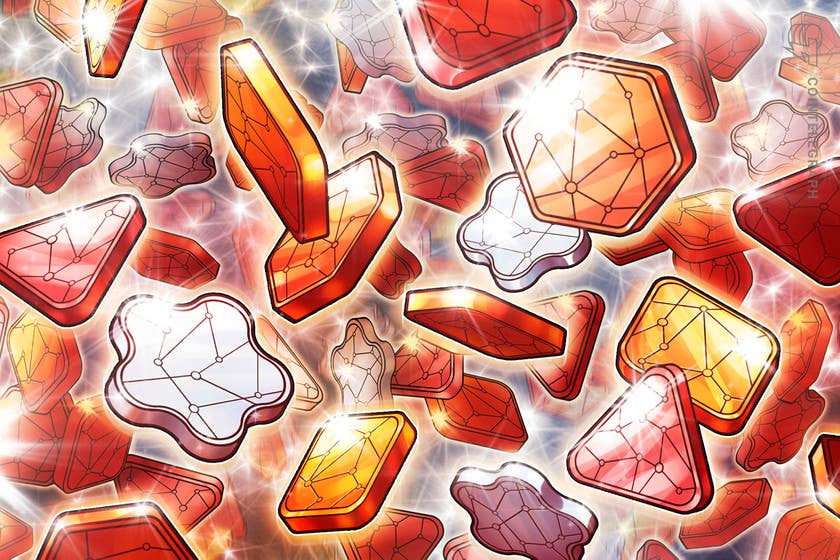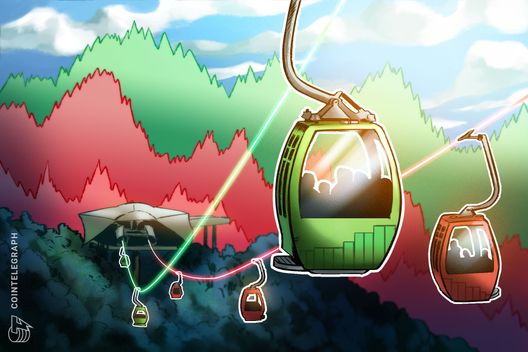Can Bitcoin’s hard cap of 21 million be changed?
What is Bitcoin? How does blockchain work? How to mine cryptocurrency? We are glad to help you answer these questions with our quick guides in Explained section.
n”,”seo_description”:”What is Bitcoin? How does blockchain work? How to mine cryptocurrency? We are glad to help you answer these questions with our quick guides in Explained section.”},”words_count”:855,”description”:”Satoshi Nakamoto, the creator of Bitcoin, set a hard cap of 21 million BTC, which means there will only ever be 21 million Bitcoin in existence”,”author”:{“id”:1415,”title”:”Jagjit Singh”,”url”:”jagjit-singh”,”twitter”:””,”google_plus”:””,”photo”:null,”gender”:”male”,”description”:”Jagjit is passionate about the blockchain and crypto space and has been closely following the trends in the crypto space. He’s himself a HODLer, which makes his voice authoritative and his writings an exciting piece of work.”,”facebook”:””,”email”:””,”linkedin”:””,”created_at”:”2021-11-03 12:47:28″,”updated_at”:”2021-11-03 12:47:28″,”deleted_at”:null,”avatar”:”https://cointelegraph.com/assets/img/icons/author_male.jpg”,”hash”:”aHR0cHM6Ly9jb2ludGVsZWdyYXBoLmNvbS9hdXRob3JzL2phZ2ppdC1zaW5naA==”,”relativeUrl”:”https://cointelegraph.com/authors/jagjit-singh”,”user_id”:1415,”language_id”:1,”name”:”Jagjit Singh”,”desc”:”Jagjit is passionate about the blockchain and crypto space and has been closely following the trends in the crypto space. He’s himself a HODLer, which makes his voice authoritative and his writings an exciting piece of work.”,”seo_title”:””,”seo_description”:””,”enabled”:0,”show_in_authors”:0,”show_in_experts”:0},”category_id”:65,”audio”:”https://s3.cointelegraph.com/audio/77422.846ece48-072f-4509-8f37-3f7cdaba928c.mp3″,”tags”:[{“name”:”Bitcoin”,”uri”:”/tags/bitcoin”,”super”:1,”page_title”:”Bitcoin News”},{“name”:”Cryptocurrencies”,”uri”:”/tags/cryptocurrencies”,”super”:0,”page_title”:”Cryptocurrencies News”},{“name”:”Market Capitalization”,”uri”:”/tags/market-capitalization”,”super”:0,”page_title”:”Market Capitalization News”}],”tag_title”:”Bitcoin”,”date”:”29 MINUTES AGO”,”badge”:{“title”:”Explained”,”label”:”default”},”qty”:3,”stats_pixel”:”“,”stats_pixel_url”:”https://zoa.cointelegraph.com/pixel?postId=77422®ionId=1″,”shares”:22,”infographic”:false,”sponsored”:false,”explained”:true,”press_release”:false,”show_referral”:false,”social_description”:””,”social_translators”:{“clipboard_popup_label”:”Link copied”,”socialWechatFooterError”:”WeChat error”,”socialWechatFooterText”:”WeChat share”,”socialWechatHeaderText”:”WeChat share”},”social_shares”:{“post_id”:77422,”post_url”:”https://cointelegraph.com/explained/can-bitcoins-hard-cap-of-21-million-be-changed”,”post_titles”:{“normal”:”Can Bitcoin’s hard cap of 21 million be changed?”,”twitter”:”Can Bitcoin’s hard cap of 21 million be changed?”},”post_text”:{“normal”:”Can Bitcoin’s hard cap of 21 million be changed?”,”twitter”:”Can Bitcoin’s hard cap of 21 million be changed? https://cointelegraph.com/explained/can-bitcoins-hard-cap-of-21-million-be-changed via @cointelegraph”},”accounts”:{“twitter”:”@cointelegraph”}},”socials”:{“facebook”:{“url”:”https://www.facebook.com/sharer/sharer.php?u=https%3A%2F%2Fcointelegraph.com%2Fexplained%2Fcan-bitcoins-hard-cap-of-21-million-be-changed”,”count”:null,”short”:”fb”,”fa”:”facebook”},”twitter”:{“url”:”https://twitter.com/intent/tweet?text=Can+Bitcoin%27s+hard+cap+of+21+million+be+changed%3F https%3A%2F%2Fcointelegraph.com%2Fexplained%2Fcan-bitcoins-hard-cap-of-21-million-be-changed via @cointelegraph”,”count”:null,”short”:”tw”,”fa”:”twitter”},”telegram”:{“url”:”https://telegram.me/share/url?url=https%3A%2F%2Fcointelegraph.com%2Fexplained%2Fcan-bitcoins-hard-cap-of-21-million-be-changed &text=Can+Bitcoin%27s+hard+cap+of+21+million+be+changed%3F”,”count”:null,”short”:”tg”,”fa”:”paper-plane”},”whatsapp”:{“url”:”https://api.whatsapp.com/send?text=Can+Bitcoin%27s+hard+cap+of+21+million+be+changed%3F&href=https%3A%2F%2Fcointelegraph.com%2Fexplained%2Fcan-bitcoins-hard-cap-of-21-million-be-changed”,”count”:null,”short”:”wu”,”fa”:”whatsapp”},”gplus”:{“url”:”https://plus.google.com/share?url=https%3A%2F%2Fcointelegraph.com%2Fexplained%2Fcan-bitcoins-hard-cap-of-21-million-be-changed”,”count”:null,”short”:”gplus”,”fa”:”google-plus”},”reddit”:{“url”:”https://www.reddit.com/submit?url=https%3A%2F%2Fcointelegraph.com%2Fexplained%2Fcan-bitcoins-hard-cap-of-21-million-be-changed&title=Can+Bitcoin%27s+hard+cap+of+21+million+be+changed%3F”,”count”:null,”short”:”reddit”,”fa”:”reddit-alien”},”linkedin”:{“url”:”https://www.linkedin.com/shareArticle?mini=true&url=https%3A%2F%2Fcointelegraph.com%2Fexplained%2Fcan-bitcoins-hard-cap-of-21-million-be-changed&title=Can+Bitcoin%27s+hard+cap+of+21+million+be+changed%3F”,”count”:null,”short”:”li”,”fa”:”linkedin”}},”hide_disclaimer”:false,”elink”:”https://cointelegraph.com”,”etitle”:”Cointelegraph”,”elogo_x2″:”https://images.cointelegraph.com/images/528_aHR0cHM6Ly9zMy5jb2ludGVsZWdyYXBoLmNvbS9zdG9yYWdlL3VwbG9hZHMvdmlldy9hYjAzYTJhMmNlOWEyMWRjMWYwOTYxZDkxNzMxYzhiYS5wbmc=.png”,”elogo_x1″:”https://images.cointelegraph.com/images/260_aHR0cHM6Ly9zMy5jb2ludGVsZWdyYXBoLmNvbS9zdG9yYWdlL3VwbG9hZHMvdmlldy9hYjAzYTJhMmNlOWEyMWRjMWYwOTYxZDkxNzMxYzhiYS5wbmc=.png”,”elogo_svg”:false,”content”:[{“id”:2912,”post_id”:77422,”title”:”What is a hard market cap?”,”content”:”
A hard cap is a parameter that the crypto analytics websites and the project’s community watch closely.
nn
A hard cap is a limit set by the code of a blockchain on the absolute maximum supply of a cryptocurrency. A hard cap prevents any further production or circulation of the cryptocurrency’s units. It is widely regarded as having a good effect since it promotes scarcity, which raises the value of each token. For instance, the hard cap of the world’s first cryptocurrency, Bitcoin (BTC), was set to 21 million by its anonymous creator, Satoshi Nakamoto.
nn
Absolute scarcity refers to a good’s finite, fixed supply. There is no additional supply response to meet higher demand when demand for an item rises. The supply is therefore entirely inelastic. Regardless of the growth in demand, you will be unable to produce more. The price is the only output that can fluctuate. This is true in the case of BTC; Bitcoin’s issuance rate and hard-capped supply stay constant regardless of how much energy is put into mining it. However, to get around this constraint, a cryptocurrency must change its basic specifications, thereby re-inventing itself.
nn
However, gold is only scarce in terms of the energy required to mine it. If we handed out shovels to everyone and urged them to start digging, there would be a lot more gold flooding the market, lowering the price.
nn
The hard cap parameter is also used while evaluating an initial coin offering (ICO). Before considering a purchase, investors and users must consider various aspects while evaluating a project or protocol. The hard and soft caps of an ICO are the most well-known parameters among such elements. A soft cap is a minimum amount that developers must raise to launch their product, whereas a hard cap is a total amount that a team hopes to raise in an ICO.
nn
While the hard limit refers to the maximum number of tokens sold during an ICO, the soft cap refers to the minimum amount of money that a project can raise to begin development. As a result, the hard cap is usually set far higher than the soft cap, as it is more of a fundraising goal than a minimum realistic target.
nnn”,”created_at”:”2021-12-07 13:23:09″,”updated_at”:”2021-12-07 13:31:30″,”sort”:1,”translations”:{“id”:2905,”explained_post_id”:2912,”title_en”:”What is a hard market cap?”,”content_en”:”
A hard cap is a parameter that the crypto analytics websites and the project’s community watch closely.
nn
A hard cap is a limit set by the code of a blockchain on the absolute maximum supply of a cryptocurrency. A hard cap prevents any further production or circulation of the cryptocurrency’s units. It is widely regarded as having a good effect since it promotes scarcity, which raises the value of each token. For instance, the hard cap of the world’s first cryptocurrency, Bitcoin (BTC), was set to 21 million by its anonymous creator, Satoshi Nakamoto.
nn
Absolute scarcity refers to a good’s finite, fixed supply. There is no additional supply response to meet higher demand when demand for an item rises. The supply is therefore entirely inelastic. Regardless of the growth in demand, you will be unable to produce more. The price is the only output that can fluctuate. This is true in the case of BTC; Bitcoin’s issuance rate and hard-capped supply stay constant regardless of how much energy is put into mining it. However, to get around this constraint, a cryptocurrency must change its basic specifications, thereby re-inventing itself.
nn
However, gold is only scarce in terms of the energy required to mine it. If we handed out shovels to everyone and urged them to start digging, there would be a lot more gold flooding the market, lowering the price.
nn
The hard cap parameter is also used while evaluating an initial coin offering (ICO). Before considering a purchase, investors and users must consider various aspects while evaluating a project or protocol. The hard and soft caps of an ICO are the most well-known parameters among such elements. A soft cap is a minimum amount that developers must raise to launch their product, whereas a hard cap is a total amount that a team hopes to raise in an ICO.
nn
While the hard limit refers to the maximum number of tokens sold during an ICO, the soft cap refers to the minimum amount of money that a project can raise to begin development. As a result, the hard cap is usually set far higher than the soft cap, as it is more of a fundraising goal than a minimum realistic target.
nnn”,”title_es”:””,”content_es”:”n”,”title_cn”:””,”content_cn”:”n”,”title_de”:””,”content_de”:”n”,”title_it”:””,”content_it”:”n”,”title_ar”:””,”content_ar”:”n”,”title_br”:””,”content_br”:”n”,”title_jp”:””,”content_jp”:”n”,”created_at”:”2021-12-07 13:23:09″,”updated_at”:”2021-12-07 13:31:30″,”title_kr”:””,”content_kr”:”n”,”title_tr”:””,”content_tr”:”n”}},{“id”:2913,”post_id”:77422,”title”:”Why do cryptocurrencies have a hard cap?”,”content”:”
An adequate hard cap is essential for two important reasons, including the scarcity of the project’s tokens and the roadmap of the project under consideration.
nn
The first is the project’s token’s scarcity. The world’s first cryptocurrency, Bitcoin, is valuable because it is limited in supply; only 21 million Bitcoins will ever be mined. Any project trying to impose a hard cap must follow the same supply and demand principles. Furthermore, the integrity and value of the underlying project will be safeguarded. Business leaders and team members, on the other hand, must strike a delicate balance to get this number right. The value of tokens decreases as the number of tokens increases, and vice versa.
nn
Second, a hard cap is intimately linked to the underlying project’s roadmap. Finally, the team should clarify how the money raised will be used, as there have been cases where initiatives have raised more money than they expected because they didn’t establish a strict cap.
nnn”,”created_at”:”2021-12-07 13:23:56″,”updated_at”:”2021-12-07 13:31:30″,”sort”:2,”translations”:{“id”:2906,”explained_post_id”:2913,”title_en”:”Why do cryptocurrencies have a hard cap?”,”content_en”:”
An adequate hard cap is essential for two important reasons, including the scarcity of the project’s tokens and the roadmap of the project under consideration.
nn
The first is the project’s token’s scarcity. The world’s first cryptocurrency, Bitcoin, is valuable because it is limited in supply; only 21 million Bitcoins will ever be mined. Any project trying to impose a hard cap must follow the same supply and demand principles. Furthermore, the integrity and value of the underlying project will be safeguarded. Business leaders and team members, on the other hand, must strike a delicate balance to get this number right. The value of tokens decreases as the number of tokens increases, and vice versa.
nn
Second, a hard cap is intimately linked to the underlying project’s roadmap. Finally, the team should clarify how the money raised will be used, as there have been cases where initiatives have raised more money than they expected because they didn’t establish a strict cap.
nnn”,”title_es”:””,”content_es”:”n”,”title_cn”:””,”content_cn”:”n”,”title_de”:””,”content_de”:”n”,”title_it”:””,”content_it”:”n”,”title_ar”:””,”content_ar”:”n”,”title_br”:””,”content_br”:”n”,”title_jp”:””,”content_jp”:”n”,”created_at”:”2021-12-07 13:23:56″,”updated_at”:”2021-12-07 13:31:30″,”title_kr”:””,”content_kr”:”n”,”title_tr”:””,”content_tr”:”n”}},{“id”:2914,”post_id”:77422,”title”:”Does Bitcoin have a hard cap?”,”content”:”
BTC’s anonymous creator has set Bitcoin’s hard cap to 21 million, i.e., BTC’s supply is limited.
nn
Satoshi Nakamoto set a hard cap on the amount of BTC that may ever exist when he invented Bitcoin. The total number of BTC will never exceed 21 million. The hard cap is a limit that is written in Bitcoin’s source code and enforced by network nodes.
nn
The hard cap on Bitcoin is critical to its value proposition as a currency and an investment tool. Bitcoin, like gold and real estate, is a successful store of value because its quantity is difficult to expand. Every four years, due to halving, producing Bitcoin becomes more complex and finally impossible.
nnn”,”created_at”:”2021-12-07 13:24:39″,”updated_at”:”2021-12-07 13:31:30″,”sort”:3,”translations”:{“id”:2907,”explained_post_id”:2914,”title_en”:”Does Bitcoin have a hard cap?”,”content_en”:”
BTC’s anonymous creator has set Bitcoin’s hard cap to 21 million, i.e., BTC’s supply is limited.
nn
Satoshi Nakamoto set a hard cap on the amount of BTC that may ever exist when he invented Bitcoin. The total number of BTC will never exceed 21 million. The hard cap is a limit that is written in Bitcoin’s source code and enforced by network nodes.
nn
The hard cap on Bitcoin is critical to its value proposition as a currency and an investment tool. Bitcoin, like gold and real estate, is a successful store of value because its quantity is difficult to expand. Every four years, due to halving, producing Bitcoin becomes more complex and finally impossible.
nnn”,”title_es”:””,”content_es”:”n”,”title_cn”:””,”content_cn”:”n”,”title_de”:””,”content_de”:”n”,”title_it”:””,”content_it”:”n”,”title_ar”:””,”content_ar”:”n”,”title_br”:””,”content_br”:”n”,”title_jp”:””,”content_jp”:”n”,”created_at”:”2021-12-07 13:24:39″,”updated_at”:”2021-12-07 13:31:30″,”title_kr”:””,”content_kr”:”n”,”title_tr”:””,”content_tr”:”n”}},{“id”:2915,”post_id”:77422,”title”:”Can Bitcoin’s hard cap be changed?”,”content”:”
By changing the Bitcoin network’s rule, its hard cap can be modified.
nn
Some Bitcoin skeptics argue that because BTC is merely software, its network rules can be readily modified. These critics say that as the block subsidy — the amount of new Bitcoin created in each block — decreases every four years, miners would want to protect their revenue stream by raising the supply cap beyond 21 million BTC.
nn
On the surface, miners would be enticed to modify the supply cap and allow themselves to generate more new Bitcoin. This adjustment, however, will not take place for a variety of reasons, as explained in the section below.
nnn”,”created_at”:”2021-12-07 13:25:09″,”updated_at”:”2021-12-07 13:31:30″,”sort”:4,”translations”:{“id”:2908,”explained_post_id”:2915,”title_en”:”Can Bitcoin’s hard cap be changed?”,”content_en”:”
By changing the Bitcoin network’s rule, its hard cap can be modified.
nn
Some Bitcoin skeptics argue that because BTC is merely software, its network rules can be readily modified. These critics say that as the block subsidy — the amount of new Bitcoin created in each block — decreases every four years, miners would want to protect their revenue stream by raising the supply cap beyond 21 million BTC.
nn
On the surface, miners would be enticed to modify the supply cap and allow themselves to generate more new Bitcoin. This adjustment, however, will not take place for a variety of reasons, as explained in the section below.
nnn”,”title_es”:””,”content_es”:”n”,”title_cn”:””,”content_cn”:”n”,”title_de”:””,”content_de”:”n”,”title_it”:””,”content_it”:”n”,”title_ar”:””,”content_ar”:”n”,”title_br”:””,”content_br”:”n”,”title_jp”:””,”content_jp”:”n”,”created_at”:”2021-12-07 13:25:09″,”updated_at”:”2021-12-07 13:31:30″,”title_kr”:””,”content_kr”:”n”,”title_tr”:””,”content_tr”:”n”}},{“id”:2916,”post_id”:77422,”title”:”Why won’t the hard cap on Bitcoin change?”,”content”:”
The hard cap on Bitcoin is secured from alteration by its incentive structure and governance mechanism. The entities that govern Bitcoin’s ruleset have significant incentives to fight a change to the hard cap because of the network’s architecture, but those who wish to change it have no power over the network.
nn
Incentives
nn
The individuals with the most incentive to modify Bitcoin’s hard cap are the miners. Changing Bitcoin’s hard cap could boost earnings for miners for a short time. However, doing so would negate one of the main arguments for investing in Bitcoin: its scarcity.
nn
The attractiveness of BTC for many investors is its predictable, fixed supply. However, it is not in miners’ best interests to remove the fundamental driver of Bitcoin’s value proposition. Although the modification will raise miner revenue in BTC terms, it would lead to a catastrophic and permanent price fall, resulting in a net loss of miner revenue in fiat terms.
nn
Miners are more concerned with their fiat-denominated earnings than their Bitcoin-denominated revenue since practically all of their costs — salaries, equipment costs, and energy bills — are paid in fiat. As a result, if Bitcoin’s price falls, miners will lose money.
nn
Bitcoin Governance
nn
The possibility of changing Bitcoin’s hard cap stems from two underlying misconceptions regarding BTC as a distributed, consensus-based network. To begin with, there are dozens, if not hundreds, of different versions of the Bitcoin source code. For example, every node in the Bitcoin network runs a software that rejects any incorrect blocks.
nn
While many nodes are running the most recent version of Bitcoin Core, some are still using older versions and implementations. As a result, while changing BTC Core’s source code is simple, convincing tens of thousands of nodes to implement these modifications is significantly more challenging.
nn
Moreover, miners have no control over the network’s rules. Instead, miners are responsible for creating new blocks and validating transactions. When miners submit a new block to the network, tens of thousands of nodes independently verify it, ensuring that it generates a suitable amount of new BTC, has legitimate proof-of-work and contains valid transactions. All blocks that break these criteria will be rejected by nodes, implying that miners have no control over Bitcoin’s ruleset.
nn
When 95% of miners agreed to lift the block size limit in 2017 in an attempt to allow Bitcoin to scale, this theory was confirmed by reality. On the other hand, nodes and users resisted the shift and successfully forced miners to switch to a different scaling method.
nnn”,”created_at”:”2021-12-07 13:26:13″,”updated_at”:”2021-12-07 13:31:30″,”sort”:5,”translations”:{“id”:2909,”explained_post_id”:2916,”title_en”:”Why won’t the hard cap on Bitcoin change?”,”content_en”:”
The hard cap on Bitcoin is secured from alteration by its incentive structure and governance mechanism. The entities that govern Bitcoin’s ruleset have significant incentives to fight a change to the hard cap because of the network’s architecture, but those who wish to change it have no power over the network.
nn
Incentives
nn
The individuals with the most incentive to modify Bitcoin’s hard cap are the miners. Changing Bitcoin’s hard cap could boost earnings for miners for a short time. However, doing so would negate one of the main arguments for investing in Bitcoin: its scarcity.
nn
The attractiveness of BTC for many investors is its predictable, fixed supply. However, it is not in miners’ best interests to remove the fundamental driver of Bitcoin’s value proposition. Although the modification will raise miner revenue in BTC terms, it would lead to a catastrophic and permanent price fall, resulting in a net loss of miner revenue in fiat terms.
nn
Miners are more concerned with their fiat-denominated earnings than their Bitcoin-denominated revenue since practically all of their costs — salaries, equipment costs, and energy bills — are paid in fiat. As a result, if Bitcoin’s price falls, miners will lose money.
nn
Bitcoin Governance
nn
The possibility of changing Bitcoin’s hard cap stems from two underlying misconceptions regarding BTC as a distributed, consensus-based network. To begin with, there are dozens, if not hundreds, of different versions of the Bitcoin source code. For example, every node in the Bitcoin network runs a software that rejects any incorrect blocks.
nn
While many nodes are running the most recent version of Bitcoin Core, some are still using older versions and implementations. As a result, while changing BTC Core’s source code is simple, convincing tens of thousands of nodes to implement these modifications is significantly more challenging.
nn
Moreover, miners have no control over the network’s rules. Instead, miners are responsible for creating new blocks and validating transactions. When miners submit a new block to the network, tens of thousands of nodes independently verify it, ensuring that it generates a suitable amount of new BTC, has legitimate proof-of-work and contains valid transactions. All blocks that break these criteria will be rejected by nodes, implying that miners have no control over Bitcoin’s ruleset.
nn
When 95% of miners agreed to lift the block size limit in 2017 in an attempt to allow Bitcoin to scale, this theory was confirmed by reality. On the other hand, nodes and users resisted the shift and successfully forced miners to switch to a different scaling method.
nnn”,”title_es”:””,”content_es”:”n”,”title_cn”:””,”content_cn”:”n”,”title_de”:””,”content_de”:”n”,”title_it”:””,”content_it”:”n”,”title_ar”:””,”content_ar”:”n”,”title_br”:””,”content_br”:”n”,”title_jp”:””,”content_jp”:”n”,”created_at”:”2021-12-07 13:26:13″,”updated_at”:”2021-12-07 13:31:30″,”title_kr”:””,”content_kr”:”n”,”title_tr”:””,”content_tr”:”n”}},{“id”:2917,”post_id”:77422,”title”:”How could Bitcoin’s hard cap be modified?”,”content”:”
Despite the above-mentioned opposing incentives, a supply cap change is potentially achievable. For example, several entities would have to work together to modify Bitcoin’s supply cap.
nn
Developers would have to suggest the modification first, then write the code to implement it. There would be a communal debate, which would almost certainly be contentious. Developers would have to agree on these improvements before they could be incorporated into Bitcoin Core.
nn
The community would then have to agree on an activation path to ensure that the network as a whole switched to the new ruleset. For example, changing the supply cap would necessitate a hard fork, which would require all nodes on the network to accept the modifications or be kicked off.
nn
Both miners and nodes can express their support for the change as part of the activation path, and after a majority of the network has signaled support, the change can be activated. Refusing the modification, nodes and miners would operate a minority fork, keeping the original Bitcoin network, with the two networks competing for market share and hash rate.
nnn”,”created_at”:”2021-12-07 13:26:49″,”updated_at”:”2021-12-07 13:31:30″,”sort”:6,”translations”:{“id”:2910,”explained_post_id”:2917,”title_en”:”How could Bitcoin’s hard cap be modified?”,”content_en”:”
Despite the above-mentioned opposing incentives, a supply cap change is potentially achievable. For example, several entities would have to work together to modify Bitcoin’s supply cap.
nn
Developers would have to suggest the modification first, then write the code to implement it. There would be a communal debate, which would almost certainly be contentious. Developers would have to agree on these improvements before they could be incorporated into Bitcoin Core.
nn
The community would then have to agree on an activation path to ensure that the network as a whole switched to the new ruleset. For example, changing the supply cap would necessitate a hard fork, which would require all nodes on the network to accept the modifications or be kicked off.
nn
Both miners and nodes can express their support for the change as part of the activation path, and after a majority of the network has signaled support, the change can be activated. Refusing the modification, nodes and miners would operate a minority fork, keeping the original Bitcoin network, with the two networks competing for market share and hash rate.
nnn”,”title_es”:””,”content_es”:”n”,”title_cn”:””,”content_cn”:”n”,”title_de”:””,”content_de”:”n”,”title_it”:””,”content_it”:”n”,”title_ar”:””,”content_ar”:”n”,”title_br”:””,”content_br”:”n”,”title_jp”:””,”content_jp”:”n”,”created_at”:”2021-12-07 13:26:49″,”updated_at”:”2021-12-07 13:31:30″,”title_kr”:””,”content_kr”:”n”,”title_tr”:””,”content_tr”:”n”}}],”is_partner_material”:false,”commentsSection”:{“schemaEntityUrl”:”//cointelegraph.com/explained/can-bitcoins-hard-cap-of-21-million-be-changed”,”list”:[],”amount”:0,”i18n”:{“addComment”:”Add a comment…”,”amountOnePostfix”:”Comment”,”amountPostfix”:”Comments”,”cancel”:”Cancel”,”delete”:”Delete”,”edit”:”Edit”,”errorBig”:”Comment text cannot be longer than 2000 characters”,”errorDuplicate”:”Duplicate comment”,”errorSmall”:”Comment text must be at least 2 characters long”,”hideButton”:”Hide comments”,”noComments”:” “,”commentOnModeration”:”Comment on moderation”,”postComment”:”Post”,”reply”:”Reply”,”showAllComments”:”Show All Comments”,”showButtonPostfix”:”comments”,”showButtonPrefix”:”Show”,”signIn”:”Sign in”,”update”:”Update comment”,”commentWasDeleted”:”This comment has been deleted”}},”related”:[{“id”:46550,”retina”:”https://images.cointelegraph.com/images/1480_aHR0cHM6Ly9zMy5jb2ludGVsZWdyYXBoLmNvbS9zdG9yYWdlL3VwbG9hZHMvdmlldy84YWM0ZTQzZGJhYTllMmViYzdhNjg3MjUxZTUxM2Q0YS5qcGc=.jpg”,”img”:”https://images.cointelegraph.com/images/740_aHR0cHM6Ly9zMy5jb2ludGVsZWdyYXBoLmNvbS9zdG9yYWdlL3VwbG9hZHMvdmlldy84YWM0ZTQzZGJhYTllMmViYzdhNjg3MjUxZTUxM2Q0YS5qcGc=.jpg”,”thumb”:”https://images.cointelegraph.com/images/370_aHR0cHM6Ly9zMy5jb2ludGVsZWdyYXBoLmNvbS9zdG9yYWdlL3VwbG9hZHMvdmlldy84YWM0ZTQzZGJhYTllMmViYzdhNjg3MjUxZTUxM2Q0YS5qcGc=.jpg”,”thumb370″:”https://images.cointelegraph.com/images/370_aHR0cHM6Ly9zMy5jb2ludGVsZWdyYXBoLmNvbS9zdG9yYWdlL3VwbG9hZHMvdmlldy84YWM0ZTQzZGJhYTllMmViYzdhNjg3MjUxZTUxM2Q0YS5qcGc=.jpg”,”amp_thumb”:”https://images.cointelegraph.com/images/150_aHR0cHM6Ly9zMy5jb2ludGVsZWdyYXBoLmNvbS9zdG9yYWdlL3VwbG9hZHMvdmlldy84YWM0ZTQzZGJhYTllMmViYzdhNjg3MjUxZTUxM2Q0YS5qcGc=.jpg”,”thumb150″:”https://images.cointelegraph.com/images/150_aHR0cHM6Ly9zMy5jb2ludGVsZWdyYXBoLmNvbS9zdG9yYWdlL3VwbG9hZHMvdmlldy84YWM0ZTQzZGJhYTllMmViYzdhNjg3MjUxZTUxM2Q0YS5qcGc=.jpg”,”url”:”https://cointelegraph.com/news/blockchain-to-disrupt-music-industry-and-make-it-change-tune”,”title”:”Blockchain to Disrupt Music Industry and Make It Change Tune”,”lead”:”Blockchain technology is tipping the scales of the music industry, shifting the power from intermediaries back to artists.”,”leadfull”:””,”category_id”:19,”category_url”:”https://cointelegraph.com/category/analysis”,”category_title”:”Analysis”,”author_url”:”https://cointelegraph.com/authors/antonio-madeira”,”author_hash”:”aHR0cHM6Ly9jb2ludGVsZWdyYXBoLmNvbS9hdXRob3JzL2FudG9uaW8tbWFkZWlyYQ==”,”author_title”:”António Madeira”,”author_img”:”https://images.cointelegraph.com/images/32_aHR0cHM6Ly9zMy5jb2ludGVsZWdyYXBoLmNvbS9zdG9yYWdlL3VwbG9hZHMvdmlldy81MTYxMjQ3NmZjNzRkNjdjNDBlYmM2Zjc1OGFiNjJkNC5qcGc=.jpg”,”date”:”JUN 06, 2020″,”flash_date”:”JUN 06, 2020″,”sponsored”:false,”press_release”:false,”sponsored_label”:”Sponsored”,”explained”:false,”badge”:{“title”:”Analysis”,”label”:”info”},”published”:{“date”:”2020-06-06 08:15:00.000000″,”timezone_type”:3,”timezone”:”Europe/London”},”stat_uniqs”:147765,”rss_date”:”Sat, 06 Jun 2020 08:15:00 +0100″,”publishedW3″:”2020-06-06T08:15:00+01:00″,”show_referral”:true,”isMagazine”:false},{“id”:77334,”retina”:”https://images.cointelegraph.com/images/1480_aHR0cHM6Ly9zMy5jb2ludGVsZWdyYXBoLmNvbS9zdG9yYWdlL3VwbG9hZHMvdmlldy81YmMzM2Y0MTkxYTViYjRiOGEyNzM5MzQ4MWI0MmUxNy5qcGVn.jpeg”,”img”:”https://images.cointelegraph.com/images/740_aHR0cHM6Ly9zMy5jb2ludGVsZWdyYXBoLmNvbS9zdG9yYWdlL3VwbG9hZHMvdmlldy81YmMzM2Y0MTkxYTViYjRiOGEyNzM5MzQ4MWI0MmUxNy5qcGVn.jpeg”,”thumb”:”https://images.cointelegraph.com/images/370_aHR0cHM6Ly9zMy5jb2ludGVsZWdyYXBoLmNvbS9zdG9yYWdlL3VwbG9hZHMvdmlldy81YmMzM2Y0MTkxYTViYjRiOGEyNzM5MzQ4MWI0MmUxNy5qcGVn.jpeg”,”thumb370″:”https://images.cointelegraph.com/images/370_aHR0cHM6Ly9zMy5jb2ludGVsZWdyYXBoLmNvbS9zdG9yYWdlL3VwbG9hZHMvdmlldy81YmMzM2Y0MTkxYTViYjRiOGEyNzM5MzQ4MWI0MmUxNy5qcGVn.jpeg”,”amp_thumb”:”https://images.cointelegraph.com/images/150_aHR0cHM6Ly9zMy5jb2ludGVsZWdyYXBoLmNvbS9zdG9yYWdlL3VwbG9hZHMvdmlldy81YmMzM2Y0MTkxYTViYjRiOGEyNzM5MzQ4MWI0MmUxNy5qcGVn.jpeg”,”thumb150″:”https://images.cointelegraph.com/images/150_aHR0cHM6Ly9zMy5jb2ludGVsZWdyYXBoLmNvbS9zdG9yYWdlL3VwbG9hZHMvdmlldy81YmMzM2Y0MTkxYTViYjRiOGEyNzM5MzQ4MWI0MmUxNy5qcGVn.jpeg”,”url”:”https://cointelegraph.com/explained/how-to-choose-a-secure-defi-wallet-explained”,”title”:”How to choose a secure DeFi wallet, explained”,”lead”:”DeFi wallets provide users with a gateway into the world of decentralized finance; the only caveat is finding the one that best supports a user’s financial goal…”,”leadfull”:””,”category_id”:65,”category_url”:”https://cointelegraph.com/explained”,”category_title”:”Explained”,”author_url”:”https://cointelegraph.com/authors/sarah-jansen”,”author_hash”:”aHR0cHM6Ly9jb2ludGVsZWdyYXBoLmNvbS9hdXRob3JzL3NhcmFoLWphbnNlbg==”,”author_title”:”Sarah Jansen”,”author_img”:”https://images.cointelegraph.com/images/32_aHR0cHM6Ly9zMy5jb2ludGVsZWdyYXBoLmNvbS9zdG9yYWdlL3VwbG9hZHMvdmlldy84N2IwYjRjMzkyZjlhYmM4ZjlhZDNiZTU3Y2FjZGJmZC5qcGc=.jpg”,”date”:”DEC 06, 2021″,”flash_date”:”DEC 06, 2021″,”sponsored”:false,”press_release”:false,”sponsored_label”:”Sponsored”,”explained”:true,”badge”:{“title”:”Sponsored”,”label”:”default”},”published”:{“date”:”2021-12-06 12:14:00.000000″,”timezone_type”:3,”timezone”:”Europe/London”},”stat_uniqs”:86,”rss_date”:”Mon, 06 Dec 2021 12:14:00 +0000″,”publishedW3″:”2021-12-06T12:14:00+00:00″,”show_referral”:false,”isMagazine”:false}]}” :shares=”{“facebook”:{“url”:”https://www.facebook.com/sharer/sharer.php?u=%URL%”,”icon”:”facebook”,”title”:”Facebook”,”sizesAllowed”:[{“size”:”lg”,”label”:”Large devices”,”breakpoint”:”> 1200px”},{“size”:”md”,”label”:”Medium devices”,”breakpoint”:”> 992px”},{“size”:”sm”,”label”:”Small tablets”,”breakpoint”:”> 768px”},{“size”:”xs”,”label”:”Smartphones”,”breakpoint”:”> 480px”},{“size”:”xxs”,”label”:”Extra small devices”,”breakpoint”:”< 480px"}],"position":1,"status":true},"twitter":{"url":"https://twitter.com/intent/tweet?text=%TEXT%","icon":"twitter","title":"Twitter","position":2,"status":true,"sizesAllowed":[{"size":"xxs","label":"Extra small devices","breakpoint":"< 480px"},{"size":"xs","label":"Smartphones","breakpoint":"> 480px”},{“size”:”sm”,”label”:”Small tablets”,”breakpoint”:”> 768px”},{“size”:”md”,”label”:”Medium devices”,”breakpoint”:”> 992px”},{“size”:”lg”,”label”:”Large devices”,”breakpoint”:”> 1200px”}]},”telegram”:{“url”:”https://t.me/share/url?url=%URL%&text=%TEXT%”,”icon”:”telegram”,”title”:”Telegram”,”position”:3,”status”:true,”sizesAllowed”:[{“size”:”xxs”,”label”:”Extra small devices”,”breakpoint”:”< 480px"},{"size":"xs","label":"Smartphones","breakpoint":"> 480px”},{“size”:”sm”,”label”:”Small tablets”,”breakpoint”:”> 768px”},{“size”:”md”,”label”:”Medium devices”,”breakpoint”:”> 992px”},{“size”:”lg”,”label”:”Large devices”,”breakpoint”:”> 1200px”}]},”linkedin”:{“url”:”https://www.linkedin.com/shareArticle?mini=true&url=%URL%&title=%TITLE%”,”icon”:”linked-in”,”title”:”LinkedIn”,”position”:5,”status”:true,”sizesAllowed”:[{“size”:”xxs”,”label”:”Extra small devices”,”breakpoint”:”< 480px"},{"size":"xs","label":"Smartphones","breakpoint":"> 480px”},{“size”:”sm”,”label”:”Small tablets”,”breakpoint”:”> 768px”},{“size”:”md”,”label”:”Medium devices”,”breakpoint”:”> 992px”},{“size”:”lg”,”label”:”Large devices”,”breakpoint”:”> 1200px”}]},”copy”:{“url”:”%URL%”,”icon”:”copy”,”position”:7,”title”:”Copy Link”,”sizesAllowed”:[{“size”:”xxs”,”label”:”Extra small devices”,”breakpoint”:”< 480px"},{"size":"xs","label":"Smartphones","breakpoint":"> 480px”},{“size”:”sm”,”label”:”Small tablets”,”breakpoint”:”> 768px”},{“size”:”md”,”label”:”Medium devices”,”breakpoint”:”> 992px”},{“size”:”lg”,”label”:”Large devices”,”breakpoint”:”> 1200px”}],”status”:true},”whatsapp”:{“url”:”https://wa.me/?text=%TITLE% %URL%”,”icon”:”whats-app”,”title”:”Whatsapp”,”sizesAllowed”:[{“size”:”xxs”,”label”:”Extra small devices”,”breakpoint”:”< 480px"},{"size":"xs","label":"Smartphones","breakpoint":"> 480px”},{“size”:”sm”,”label”:”Small tablets”,”breakpoint”:”> 768px”},{“size”:”md”,”label”:”Medium devices”,”breakpoint”:”> 992px”},{“size”:”lg”,”label”:”Large devices”,”breakpoint”:”> 1200px”}],”position”:6,”status”:true},”reddit”:{“url”:”https://www.reddit.com/submit?url=%URL%&title=%TITLE%”,”icon”:”reddit”,”title”:”Reddit”,”sizesAllowed”:[{“size”:”xxs”,”label”:”Extra small devices”,”breakpoint”:”< 480px"},{"size":"xs","label":"Smartphones","breakpoint":"> 480px”},{“size”:”sm”,”label”:”Small tablets”,”breakpoint”:”> 768px”},{“size”:”md”,”label”:”Medium devices”,”breakpoint”:”> 992px”},{“size”:”lg”,”label”:”Large devices”,”breakpoint”:”> 1200px”}],”position”:4,”status”:true}}” is=”ExplainedPostPage”>
A hard cap is a parameter that the crypto analytics websites and the project’s community watch closely.
A hard cap is a limit set by the code of a blockchain on the absolute maximum supply of a cryptocurrency. A hard cap prevents any further production or circulation of the cryptocurrency’s units. It is widely regarded as having a good effect since it promotes scarcity, which raises the value of each token. For instance, the hard cap of the world’s first cryptocurrency, Bitcoin (BTC), was set to 21 million by its anonymous creator, Satoshi Nakamoto.
Absolute scarcity refers to a good’s finite, fixed supply. There is no additional supply response to meet higher demand when demand for an item rises. The supply is therefore entirely inelastic. Regardless of the growth in demand, you will be unable to produce more. The price is the only output that can fluctuate. This is true in the case of BTC; Bitcoin’s issuance rate and hard-capped supply stay constant regardless of how much energy is put into mining it. However, to get around this constraint, a cryptocurrency must change its basic specifications, thereby re-inventing itself.
However, gold is only scarce in terms of the energy required to mine it. If we handed out shovels to everyone and urged them to start digging, there would be a lot more gold flooding the market, lowering the price.
The hard cap parameter is also used while evaluating an initial coin offering (ICO). Before considering a purchase, investors and users must consider various aspects while evaluating a project or protocol. The hard and soft caps of an ICO are the most well-known parameters among such elements. A soft cap is a minimum amount that developers must raise to launch their product, whereas a hard cap is a total amount that a team hopes to raise in an ICO.
While the hard limit refers to the maximum number of tokens sold during an ICO, the soft cap refers to the minimum amount of money that a project can raise to begin development. As a result, the hard cap is usually set far higher than the soft cap, as it is more of a fundraising goal than a minimum realistic target.
An adequate hard cap is essential for two important reasons, including the scarcity of the project’s tokens and the roadmap of the project under consideration.
The first is the project’s token’s scarcity. The world’s first cryptocurrency, Bitcoin, is valuable because it is limited in supply; only 21 million Bitcoins will ever be mined. Any project trying to impose a hard cap must follow the same supply and demand principles. Furthermore, the integrity and value of the underlying project will be safeguarded. Business leaders and team members, on the other hand, must strike a delicate balance to get this number right. The value of tokens decreases as the number of tokens increases, and vice versa.
Second, a hard cap is intimately linked to the underlying project’s roadmap. Finally, the team should clarify how the money raised will be used, as there have been cases where initiatives have raised more money than they expected because they didn’t establish a strict cap.
BTC’s anonymous creator has set Bitcoin’s hard cap to 21 million, i.e., BTC’s supply is limited.
Satoshi Nakamoto set a hard cap on the amount of BTC that may ever exist when he invented Bitcoin. The total number of BTC will never exceed 21 million. The hard cap is a limit that is written in Bitcoin’s source code and enforced by network nodes.
The hard cap on Bitcoin is critical to its value proposition as a currency and an investment tool. Bitcoin, like gold and real estate, is a successful store of value because its quantity is difficult to expand. Every four years, due to halving, producing Bitcoin becomes more complex and finally impossible.
By changing the Bitcoin network’s rule, its hard cap can be modified.
Some Bitcoin skeptics argue that because BTC is merely software, its network rules can be readily modified. These critics say that as the block subsidy — the amount of new Bitcoin created in each block — decreases every four years, miners would want to protect their revenue stream by raising the supply cap beyond 21 million BTC.
On the surface, miners would be enticed to modify the supply cap and allow themselves to generate more new Bitcoin. This adjustment, however, will not take place for a variety of reasons, as explained in the section below.
The hard cap on Bitcoin is secured from alteration by its incentive structure and governance mechanism. The entities that govern Bitcoin’s ruleset have significant incentives to fight a change to the hard cap because of the network’s architecture, but those who wish to change it have no power over the network.
Incentives
The individuals with the most incentive to modify Bitcoin’s hard cap are the miners. Changing Bitcoin’s hard cap could boost earnings for miners for a short time. However, doing so would negate one of the main arguments for investing in Bitcoin: its scarcity.
The attractiveness of BTC for many investors is its predictable, fixed supply. However, it is not in miners’ best interests to remove the fundamental driver of Bitcoin’s value proposition. Although the modification will raise miner revenue in BTC terms, it would lead to a catastrophic and permanent price fall, resulting in a net loss of miner revenue in fiat terms.
Miners are more concerned with their fiat-denominated earnings than their Bitcoin-denominated revenue since practically all of their costs — salaries, equipment costs, and energy bills — are paid in fiat. As a result, if Bitcoin’s price falls, miners will lose money.
Bitcoin Governance
The possibility of changing Bitcoin’s hard cap stems from two underlying misconceptions regarding BTC as a distributed, consensus-based network. To begin with, there are dozens, if not hundreds, of different versions of the Bitcoin source code. For example, every node in the Bitcoin network runs a software that rejects any incorrect blocks.
While many nodes are running the most recent version of Bitcoin Core, some are still using older versions and implementations. As a result, while changing BTC Core’s source code is simple, convincing tens of thousands of nodes to implement these modifications is significantly more challenging.
Moreover, miners have no control over the network’s rules. Instead, miners are responsible for creating new blocks and validating transactions. When miners submit a new block to the network, tens of thousands of nodes independently verify it, ensuring that it generates a suitable amount of new BTC, has legitimate proof-of-work and contains valid transactions. All blocks that break these criteria will be rejected by nodes, implying that miners have no control over Bitcoin’s ruleset.
When 95% of miners agreed to lift the block size limit in 2017 in an attempt to allow Bitcoin to scale, this theory was confirmed by reality. On the other hand, nodes and users resisted the shift and successfully forced miners to switch to a different scaling method.
Despite the above-mentioned opposing incentives, a supply cap change is potentially achievable. For example, several entities would have to work together to modify Bitcoin’s supply cap.
Developers would have to suggest the modification first, then write the code to implement it. There would be a communal debate, which would almost certainly be contentious. Developers would have to agree on these improvements before they could be incorporated into Bitcoin Core.
The community would then have to agree on an activation path to ensure that the network as a whole switched to the new ruleset. For example, changing the supply cap would necessitate a hard fork, which would require all nodes on the network to accept the modifications or be kicked off.
Both miners and nodes can express their support for the change as part of the activation path, and after a majority of the network has signaled support, the change can be activated. Refusing the modification, nodes and miners would operate a minority fork, keeping the original Bitcoin network, with the two networks competing for market share and hash rate.








